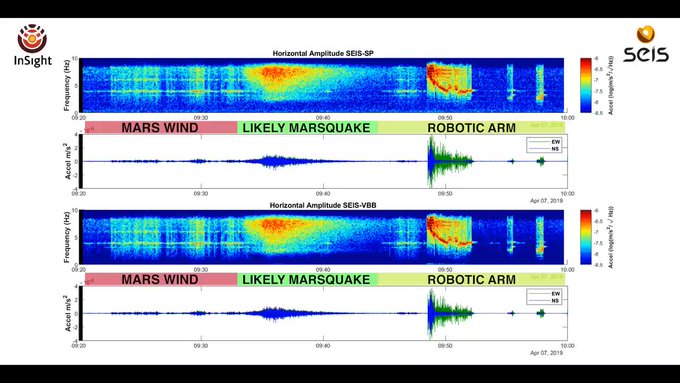It's like... as hard as rocket science, you could say.
You are using an out of date browser. It may not display this or other websites correctly.
You should upgrade or use an alternative browser.
You should upgrade or use an alternative browser.
Astronomy and space exploration
- Thread starter eloic
- Start date
In a few hours (2:49 a.m. EST, 07:49 GMT):
Watch live here:
https://www.space.com/43231-spacex-demo-1-flight-iss-explainer.htmlSpaceX Dragon Crew Demo-1 Flight to Space Station: Full Coverage
By Mike Wall a day ago News
SpaceX is gearing up for a big human-spaceflight milestone.
Elon Musk's company aims to fly the first demonstration mission of its Crew Dragon capsule to the International Space Station (ISS) on March 2.
This flight, known as Demo-1, will be uncrewed. But if all goes well, Crew Dragon will likely carry astronauts to and from the orbiting lab for the first time this summer.
Watch live here:
hoom
Veteran
Another Electron Launch
I love that you can hear native bird calls on the audio.
Holy crap, looking at the wiki page future missions apparently they have 2* friggin' moon missions later in 2019
https://en.wikipedia.org/wiki/MX-1E
Gonna drop a little lander on Malapert Mountain on the South Pole which is nearly permanently in sunlight & has permanent LoS to Earth.

I didn't even know it was possible for such a small rocket to generate enough velocity to get that far.
Edit: updated video link since it broke.
Holy crap, looking at the wiki page future missions apparently they have 2* friggin' moon missions later in 2019
https://en.wikipedia.org/wiki/MX-1E
Gonna drop a little lander on Malapert Mountain on the South Pole which is nearly permanently in sunlight & has permanent LoS to Earth.

I didn't even know it was possible for such a small rocket to generate enough velocity to get that far.
Edit: updated video link since it broke.
Last edited:
https://www.space.com/3d-printed-mars-habitats-nasa-prizes.htmlNASA Announces $100,000 Winners of Virtual 3D-Printed Mars Habitats
By Elizabeth Howell 4 hours ago Tech

One of the winning teams of a NASA competition to make a full-scale Mars habitat using modeling software, Team SEArch+/Apis Cor, designed this Martian abode, which is built from the upper part of a Hercules Single-Stage Reusable Vehicle.
(Image: © Team SEArch+/Apis Cor)
NASA picked three teams to share a $100,000 prize from a competition to make virtual Martian habitats.
The 11 participating groups were tasked with making a full-scale habitat using modeling software, building on an earlier stage of the competition that required partial virtual modeling.
The teams were graded on their layout, programming, use of interior space, and their habitat's ability to be scaled to full size for construction, according to a NASA statement announcing the winners. The groups also received points for their aesthetic representation and realism.
All of them look so nice!
http://astronomy.com/news/2019/04/event-horizon-telescope-releases-first-ever-black-hole-imageEvent Horizon Telescope releases first ever black hole image
After decades of theorizing about the possibility of catching a black hole image, astronomers have finally pulled it off. The results offer new insights into the mysterious objects.
By Korey Haynes | Published: Wednesday, April 10, 2019
The first ever image of a black hole shows the supermassive black hole in the heart of galaxy M87.
vent Horizon Telescope
On Wednesday, astronomers revealed the first image ever taken of a black hole, bringing a dramatic conclusion to a decades-long effort. The iconic image offers humanity its first glimpse at the gas and debris that swirl around its event horizon, the point beyond which material disappears forever. A favorite object of science fiction has finally been made real on screen.
Lol at the comments!
There is a certain amount of silliness in those comments.
The image is very impressive, given the angular sizes we are talking about. Maybe not as immediately majestic as some of the imagery to come from HST or the planetary missions within the Solar System, but microarcsecond imaging is challenging to say the least. Kind of reminds me of the ALMA images of a protoplanetary discs. All of those seminars I've sat through saying "this is what our theoretical models predict, obviously we'll never actually image this", well they have data now to challenge their models. Good stuff.
The image is very impressive, given the angular sizes we are talking about. Maybe not as immediately majestic as some of the imagery to come from HST or the planetary missions within the Solar System, but microarcsecond imaging is challenging to say the least. Kind of reminds me of the ALMA images of a protoplanetary discs. All of those seminars I've sat through saying "this is what our theoretical models predict, obviously we'll never actually image this", well they have data now to challenge their models. Good stuff.
For better resolution it's not so much a question of more telescopes, just a longer baseline between them.
From what I know of the EHT they are aiming at ~Earth diameter separation, but obviously going beyond that is a different ball-game altogether. Additional space-borne radio telescopes would potentially help a lot with resolving power, but would be very expensive. Data rates are high.
Another option would be to try to perform the imaging at shorter wavelengths, but that carries it's own challenges.
From what I know of the EHT they are aiming at ~Earth diameter separation, but obviously going beyond that is a different ball-game altogether. Additional space-borne radio telescopes would potentially help a lot with resolving power, but would be very expensive. Data rates are high.
Another option would be to try to perform the imaging at shorter wavelengths, but that carries it's own challenges.
I haven't found any specific info on that.How many telescopes do they need to zoom and enhance.
Additional space-borne radio telescopes would potentially help a lot with resolving power, but would be very expensive. Data rates are high.
Right. The physical size of radio telescopes is a lot bigger than optical ones. The resolution is limited by the baseline distance, so you gain little by operating these telescopes in LEO. You would want to operate them in very high orbits which comes with a higher cost.
Considering the bandwidth requirements got them to ship hard drives around the world I think it would be hard to communicate the data to earth.
Cheers
Right. The physical size of radio telescopes is a lot bigger than optical ones. The resolution is limited by the baseline distance, so you gain little by operating these telescopes in LEO. You would want to operate them in very high orbits which comes with a higher cost.
Considering the bandwidth requirements got them to ship hard drives around the world I think it would be hard to communicate the data to earth.
Having some on the Moon might be a useful baseline, and from there it might be possible to use optical communication back to Earth for the high-bandwidth. There have already been proposals for radio telescopes on the far side of the Moon to block out unwanted radio spam from the human race. Options such as that though are easily 50 years away.
A bit old, but...
https://futurism.com/nasa-insight-lander-first-marsquake
NASA’s InSight Mars Lander Just Recorded Its First Ever Marsquake
A NASA scientist said the finding "officially kicks off a new field: Martian seismology."
Victor Tangermann April 23rd 2019
“Mars, I Hear You”
In a video uploaded to Twitter on Tuesday afternoon, NASA’s InSight lander showed off a recording of “faint rumbles” that “appear to have come from the inside of the planet” — in other words, likely the first marsquake it’s ever detected.
✔@NASAInSight
Mars, I hear you. I’ve detected some quiet but distinct shaking on #Mars. The faint rumbles appear to have come from the inside of the planet, and are still being studied by my team. Take a listen.http://go.nasa.gov/2GCEBtm
It’s the first time NASA’s InSight lander has detected a marsquake, according to Space.com. The clip was recorded on April 6.
https://futurism.com/nasa-insight-lander-first-marsquake
Well, I'm not an expert, but I guess it can help determine if there's still some tectonic or volcanic activity, and how alive the core of the planet is, rather than just dead rock.What are the implications of being seismically active still (loaded question)?
Similar threads
- Replies
- 70
- Views
- 20K



